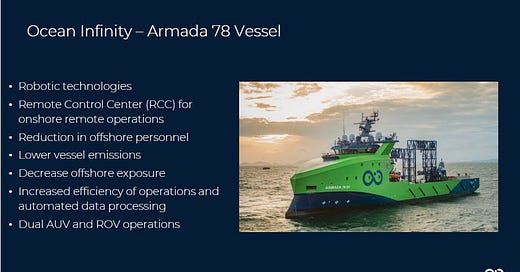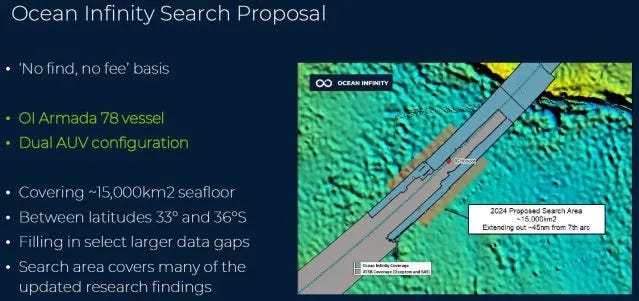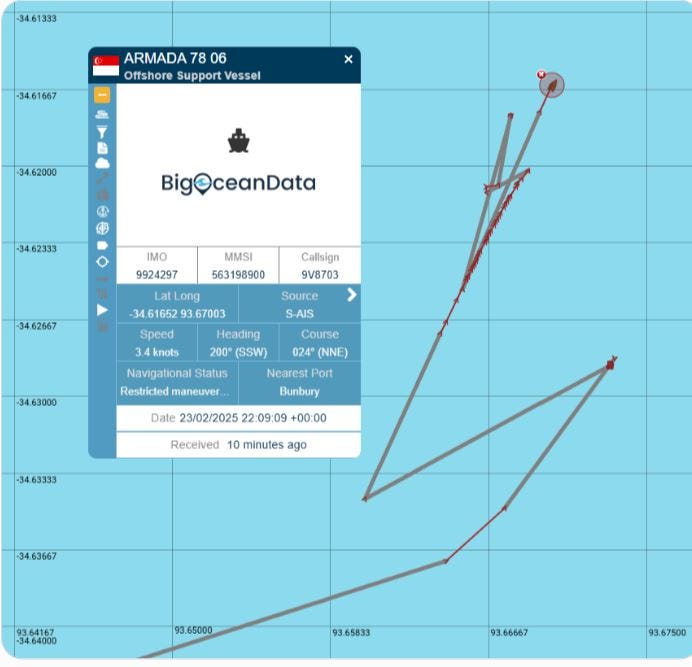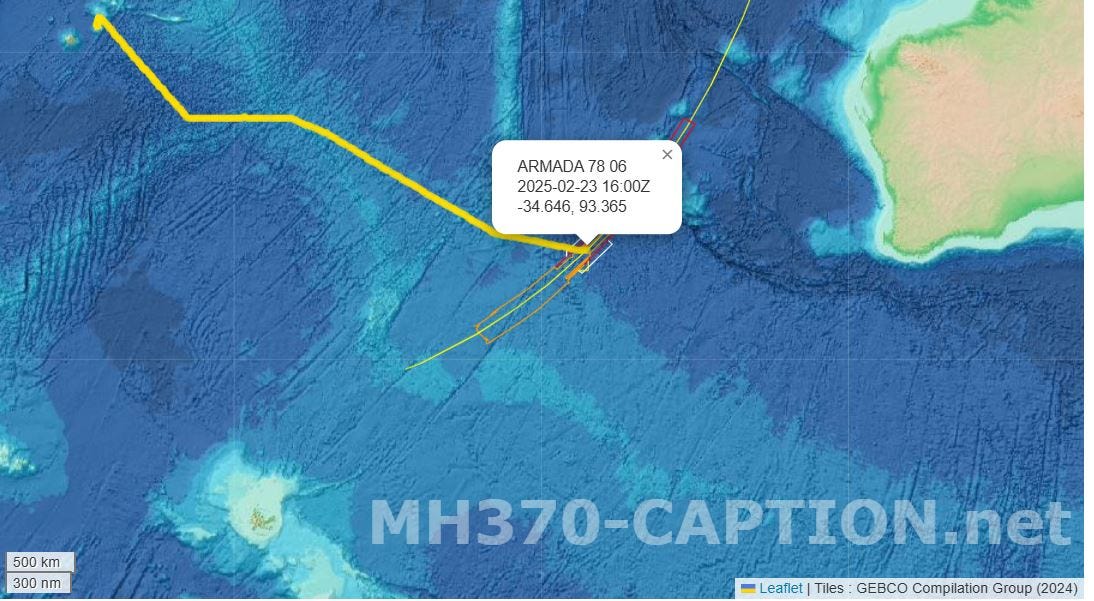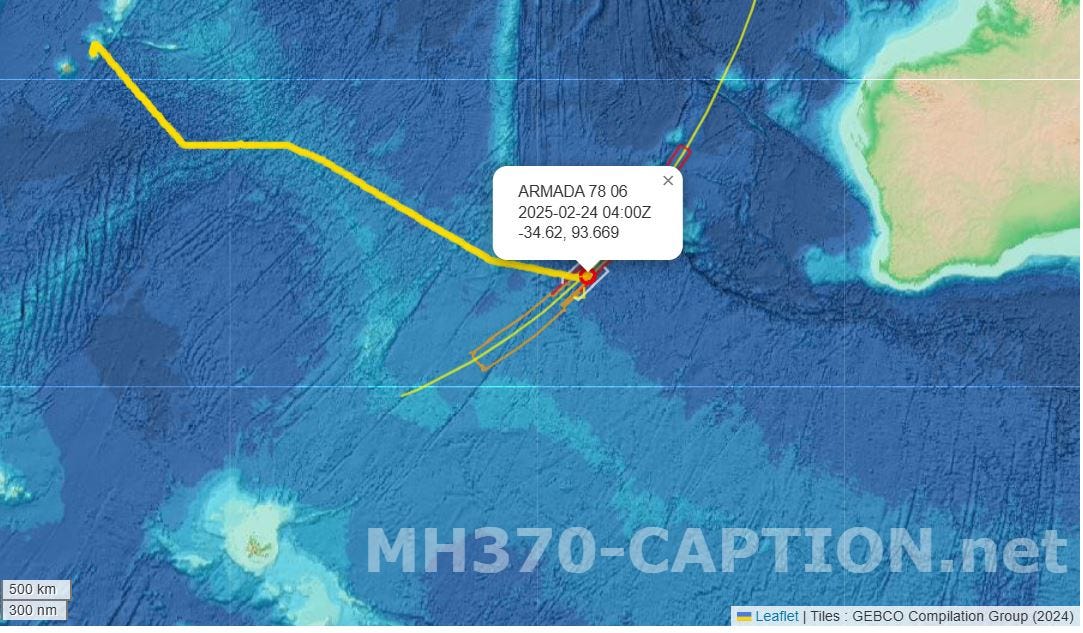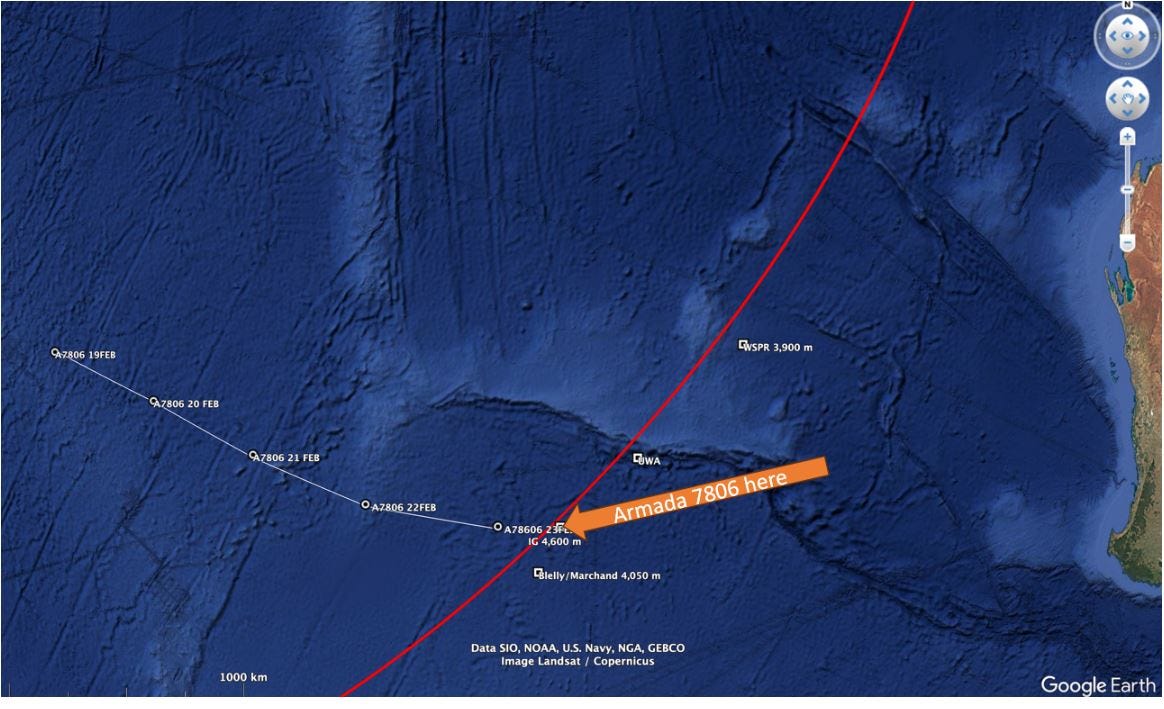As Ocean Infinity vessel reaches target area of southern Indian Ocean a new search for MH370 looks imminent
UPDATE: Investigators and commentators watching the manoeuvres of Armada 78 06 say those manoeuvres suggest that Ocean Infinity has already deployed at least one Autonomous Underwater Vehicle. Armada 78 06 is currently in an area that was partially scoured in Ocean Infinity’s previous search.
The Armada 78 06 vessel belonging to the US-based seabed exploration company Ocean Infinity has arrived in the area of the southern Indian Ocean where MH370 is thought to have crashed and a new search for the missing aircraft looks imminent.
The draft ‘no find, no fee’ agreement between the Malaysian government and Ocean Infinity about a new search for MH370 is still undergoing final review in the attorney general’s office in Malaysia.
Next of kin of those who were on board MH370 when it disappeared, and others who have been closely observing Armada 78 06’s movements, are wondering if Ocean Infinity will begin a search without a contract being signed or whether the Malaysian government will finally formally agree to the search before it begins.
Malaysia’s transport minister, Anthony Loke, said on February 20 that the contract for a new search for MH370 by Ocean Infinity was expected to be finalised in the coming days.
“We have yet to sign the contract. The contract is still with the attorney general and the terms should be finalised in the next few days,” Loke told KiniTV when questioned during a dinner function.
Lt Col Muhammad Amir bin Abdullah from Malaysia’s Air Accident Investigation Bureau had earlier said in an email sent to Daniel Schurter at the Swiss online newspaper Watson, published by CH Media, that formalisation of the agreement between the Malaysian government and Ocean Infinity was initially scheduled for mid-February this year.
“However, this process has been temporarily postponed, as the agreement is still undergoing final review by the Attorney General’s Office,” the lieutenant colonel wrote in the email dated February 13 in answer to one of Schurter’s questions.
Muhammad Amir added: “While the financial aspects are a significant consideration, the Malaysian government is also evaluating several other critical factors.
“The comprehensive review, which is currently being finalised by the Attorney General’s Office, is ensuring that all pertinent issues are thoroughly addressed before the agreement can be concluded.
“The commencement of the search is contingent upon the finalisation of the agreement between the government of Malaysia and Ocean Infinity.
“Once the agreement has been completed and all necessary formalities are in place, we will be in a position to confirm a definitive start date for the search operations.”
It is now two months since the Malaysian Cabinet agreed in principle to accept Ocean Infinity’s proposal to proceed with seabed search operations to locate the wreckage of flight MH370.
It is nearly 11 years since MH370 went missing on March 8, 2014, with 239 passengers and crew on board. It was en route from Kuala Lumpur to Beijing.
On December 20 last year, Anthony Loke, announced that, on December 13, the Malaysian Cabinet had agreed in principle to accept Ocean Infinity’s proposal “to proceed with seabed search operations to locate the wreckage of flight MH370 in a new area estimated at 15,000 square kilometres in the southern Indian Ocean”.
The CEO of Ocean Infinity, Oliver Plunkett, said after the announcement: “After a long wait, transport minister Anthony Loke’s statement is great news.
“We look forward to sharing further updates in the new year once we’ve finalised the details and the team gets ready to go.”
The company has not issued a further statement since then.
Ocean Infinity is expected to focus on an area between latitudes 33°S and 36°S, wider from the 7th Arc than was previously searched. Given the weather in the southern Indian Ocean, it’s thought the search will begin to the south then move north.
The original decision to search for MH370 in the southern Indian Ocean was based on calculations by the British company Inmarsat that were based on satellite pings – or handshakes – from MH370. Inmarsat said MH370 was most likely to be found along what became known as the 7th Arc.
In its previous search in 2018, Ocean Infinity used a leased Norwegian vessel, Seabed Constructor, and its own Autonomous Underwater Vehicles (AUVs), capable of operating in depths up to 6,000 metres.
It now has new robotic vessels that can be operated completely remotely, with no crew on board.
The AUVs being used in the current search are able to spend up to four days submerged.
Ocean Infinity is seeking a US$70 million fee if the wreckage is found. This is similar to the fee proposed for the search in 2018. Loke has said that the company’s contract with the Malaysian government would cover a period of 18 months.
Investigators have been following the movements of Ocean Infinity’s robotic vessel Armada 78 06.
Armada 78 06 had been showing its destination as ‘Offshore, Australia’ and has now arrived in the area where it is expected to begin its search.
In 2018, Ocean Infinity spent more than three months searching for MH370 in the southern Indian Ocean. The company scoured, and collected data from, more than 112,000 square kilometres of ocean floor, which is far in excess of the initial 25,000-square-kilometre target and almost the same area as was examined in the previous search over a period of two and a half years.
The previous Australian-led underwater search was suspended on January 17, 2017, after an area spanning 120,000 square kilometres was scoured.
American amateur investigator Blaine Gibson, who has found, retrieved, and/or handed in 22 pieces of debris says he supports Ocean Infinity’s proposal, but, if the plane is not found between latitudes 33°S and 36°S, he would like to see the search extended north to about 28.3°S.
Any search should include the area from 28.3°S to 33.2°S, which is the area suggested by oceanographer Charitha Pattiaratchi from The University of Western Australia (UWA) in Perth, Gibson says.
Gibson and Pattiaratchi argue that any new search should not be focused too narrowly along the 7th Arc.
They have identified Broken Ridge, at 32.5°S 96.5°E, as the most important ‘hotspot’.
Independent investigator Richard Godfrey thinks that MH370’s location is further north than previously thought and he has urged Ocean Infinity to search the possible crash location defined in his most recent research: within a radius of 30 km centred on 29.128°S 99.934°E. Less than half of the area Godfrey suggests has been previously scoured.
Godfrey has conducted analyses using the Global Detection and Tracking of Any Aircraft Anywhere (GDTAAA) software based on WSPR data, which is publicly available on WSPRnet.
Some investigators find Godfrey’s analysis compelling, but others are more sceptical. Several professional pilots have asserted that WSPR data cannot provide information that is useful for aircraft tracking.
Godfrey monitored radio signals sent out by radio amateurs around the world. Hundreds of these signals are sent out every two minutes.
He explains that, when the radio signals cross the path of an aircraft, it is possible to detect changes in the signal level and in the frequency.
Areas that other investigators argue should be searched include one suggested by Jean-Luc Marchand from Belgium and retired Air France pilot Patrick Blelly that has not previously been searched and is around a 35.7°S 93°E centrepoint.
There is also an area suggested by Victor Iannello and Bobby Ulich that has already been partly searched, but which Iannello and Ulich say needs scouring again, with a widened scope. This area is centred on 34.2°S 93.8°E. (UPDATE: Armada 78 06 is now in this area.)
Several commentators, including independent investigator Mike Exner and vessel tracker Kevin Rupp, who have been studying Armada 78 06’s movements, say it appears that Ocean Infinity has already deployed AUVs in the ocean.
Exner tweeted today (Monday) that the vessel’s manoeuvring (pictured below) was “consistent with AUV deployment (not verified)”.
Blelly is providing tracking information for Armada 78 06 on the MH370-CAPTION website. He explains that the potential search area as presented in March 2024 during the 10th anniversary remembrance event in Kuala Lumpur is shown by the white lines and this includes the zone centred on 35.7°S 93°E.
The map pictured below, which shows the track of Armada 78-06, is interactive on the MH370-CAPTION website and the vessel’s position is updated at 30 minutes past the hour UTC (90 minutes behind real time).
Blelly explains that the orange line on the map illustrates the zone scanned during Phase 2 marine surveys conducted by the governments of Australia, Malaysia, and China between September 2014 and January 2017 and the red line illustrates Ocean Infinity’s search in 2018.
UPDATED TRACKING February 24:
New image courtesy of the editor-in-chief of Airline Ratings, Geoffrey Thomas:
This article is also available on my Changing Times website.
All my articles are freely accessible, but I do need the support of my readers. If you like my articles, please do share them. If you wish to support my work financially with a donation please click this PayPal link.
If you would like to take out a paid subscription to my Changing Times website, there are PayPal subscription buttons on the website.
Thanks to all those who already support me and thanks in advance to those who will be supporting me in the future.
